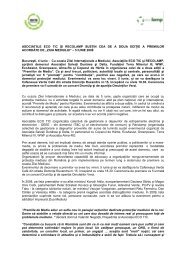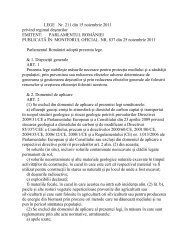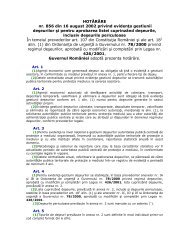PCB's in Small Capacitors from Waste Electrical and ... - Ecotic
PCB's in Small Capacitors from Waste Electrical and ... - Ecotic
PCB's in Small Capacitors from Waste Electrical and ... - Ecotic
You also want an ePaper? Increase the reach of your titles
YUMPU automatically turns print PDFs into web optimized ePapers that Google loves.
PCB’s <strong>in</strong> <strong>Small</strong> <strong>Capacitors</strong> <strong>from</strong> <strong>Waste</strong> <strong>Electrical</strong> <strong>and</strong> Electronic Equipments<br />
Table 6 Identifi ed <strong>in</strong>dividual substances <strong>and</strong> substance classes <strong>in</strong> the capacitor samples<br />
N° Orig<strong>in</strong> of <strong>Capacitors</strong> Possible Compounds / Substance Classes<br />
Large Household Appliances (LHA), <strong>Small</strong> Household Appliances (SHA)<br />
1 LHA mixture naphthalene, hydrocarbons, chlor<strong>in</strong>ated naphthalene, phthalates<br />
2 Dishwashers naphthalene, hydrocarbons, biphenyls, chlor<strong>in</strong>ated naphthalene,<br />
phthalates<br />
3 SHA mixture, without microwave<br />
devices<br />
hydrocarbons, methyl-naphthalene, chlor<strong>in</strong>ated naphthalene<br />
4 Microwave devices biphenyls (for ex. ethyl methyl), phthalates<br />
5 Cool<strong>in</strong>g <strong>and</strong> freez<strong>in</strong>g appliances naphthalene, benzyl-methylbenzene, hydrocarbons, biphenyls,<br />
triphenyl phosphate, phthalates, phosphoric acid ester<br />
6 Ballasts <strong>in</strong> fl uorescent tube lamps phthalates<br />
IT (Information Technology) / CE (Consumer Electronics) / UPS (un<strong>in</strong>terruptible power supply systems)<br />
7 IT / CE: capacitors < 1 cm hydroxybutyric acid, chloro-butyrophenon, phthalates, fatty acid,<br />
fatty acid ester, hexabrome benzene<br />
8 IT / CE: capacitors 1 –2.5 cm dimethylacetamide, hydroxybenzoic acid, benzyl alcohol, dimehylbenzyl<br />
alcohol, dibenzoyloxy-heptane-diamide, benzoic acid ester,<br />
chlor<strong>in</strong>ated naphthalene, carbonic acids, fatty acid ester, hexabrome<br />
benzene, phthalates, phosphoric acid ester<br />
9 IT / CE: capacitors > 2.5 cm Dimethyl acetamide, hydroxybutyric acid, methyl pirrolidon, benzoic<br />
acid chlorethyl ester, benzoic acid ester, tetrabutyl ammonium cyanide,<br />
butoxyethoxy-ethyl acetate, biphenyls, chlor<strong>in</strong>ated naphthalene,<br />
phthalates<br />
10 UPS hydrocarbons<br />
3.4 GC-ECD / FID F<strong>in</strong>gerpr<strong>in</strong>t Analysis<br />
Bulk sample N° 4 “microwave devices” was submitted<br />
to a differentiated analysis, <strong>in</strong> order to enable, as much<br />
as possible, more precise statements on the di-electrodes<br />
<strong>and</strong> electrolytes used after the PCB prohibition.<br />
The samples were prepared so as to allow <strong>in</strong>dividual<br />
identifi cations with<strong>in</strong> the substance classes, <strong>in</strong>clud<strong>in</strong>g<br />
quantifi cation. Table 7 displays the results.<br />
Two signifi cant substance groups could be traced with<br />
a fi ngerpr<strong>in</strong>t measure by GC-ECD / FID: a technical mixture<br />
of alkylated biphenyls <strong>and</strong> a technical mixture of<br />
phthalates with<strong>in</strong> DINP <strong>and</strong> DIDP range (di-isononyl<br />
phthalate <strong>and</strong> di-isodecyl phthalate). The identifi cation<br />
of <strong>in</strong>dividual substances was not obvious <strong>and</strong> led to<br />
probabilities <strong>in</strong> the laboratory report. But these are<br />
clearly technical mixtures as used <strong>in</strong> typical products for<br />
high-tension capacitors <strong>in</strong> microwave ovens (see paragraph<br />
4.3). With that, the results of the GC-MS full scan<br />
analysis could be asserted. The quantifi cation of these<br />
ma<strong>in</strong> components revealed that especially a very high<br />
amount of substituted biphenyls (18%) is found <strong>in</strong> capacitors<br />
<strong>from</strong> microwave devices. In opposition, the<br />
amount of phthalates is situated <strong>in</strong> the per thous<strong>and</strong><br />
range.<br />
Table 7 Quantifi cation of ma<strong>in</strong> components <strong>in</strong> capacitors <strong>from</strong> microwave devices (bulk sample Nº 4)<br />
Substance Group [ mg/kg ]<br />
Sum of biphenyls: (substituted by 4 methyl groups at most) 180’000<br />
Sum of DINP (di-isononyl phthalates) <strong>and</strong> DIDP (di-isodecyl phthalates) 2’150<br />
12









